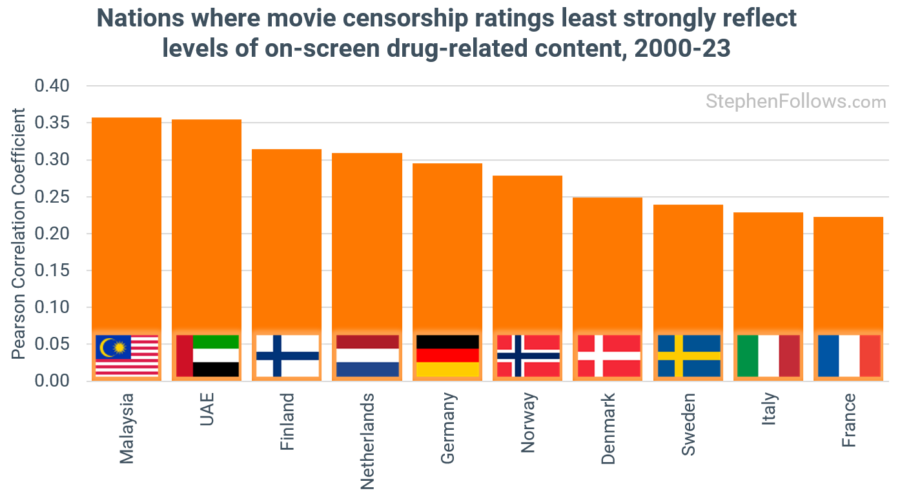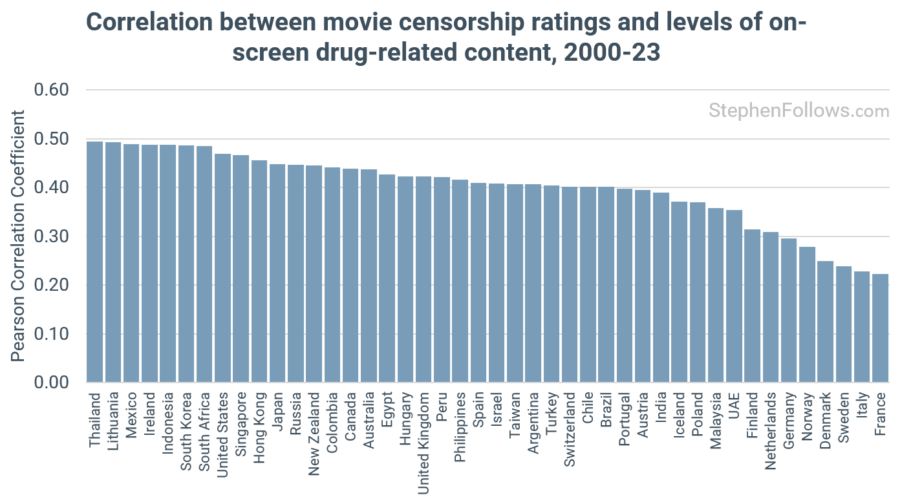Which nations rate drug content in movies most harshly?
Countries vary widely in their approach to film censorship, particularly regarding the portrayal of drugs. While some nations adopt strict stances and grant harsher ratings to films featuring drug use, others take a more permissive approach.
In the past, I have looked at how censorship bodies around the world treat sexual content and violence, so now it’s time we say yes to drugs.
We’ll explore how different countries rate films based on their drug content by analysing almost 6,000 films released since 2000. Using data from 44 international rating bodies, we investigated the Pearson correlation between film ratings and the level of drug content to identify which nations are most concerned about on-screen drug use.
The nations most concerned about drug content in movies
When it comes to rating films with drug-related content, several countries emerge as particularly stringent. Topping the list is Thailand, which, along with Lithuania, Mexico, and Ireland, has a Pearson correlation coefficient of 0.49. This indicates a strong and consistent tendency by these nations to assign more severe ratings to films containing drug content.
Countries like Indonesia and South Korea also join the highest ranks with the same correlation value of 0.49. These similarities across diverse regions highlight shared cultural and social concerns about the portrayal of drugs in media.
The nations least concerned about drugs
On the other end of the spectrum, are a number of European nations. France emerges with the lowest correlation, having a Pearson coefficient of just 0.22, and Italy shows a similarly lenient stance (0.23). This approach might be rooted in a cultural emphasis on artistic expression and a less paternalistic view of media consumption.
Other countries with low correlations include Sweden (0.24) and Denmark (0.25), which are often noted for their liberal media policies. These nations seem less inclined to let the presence of drug content alone dictate the severity of a film’s rating.
A global perspective on drug censorship
By looking at the data from all 44 rating bodies I studied, we can see distinct regional trends in how countries handle film content related to drugs.
Countries with stronger correlations, such as Thailand, Lithuania, and Mexico, demonstrate a cautious approach, possibly due to stringent national drug policies and a societal inclination to shield viewers from drug-related content. This high level of sensitivity spans diverse regions, from Southeast Asia to Europe and North America.
In contrast, nations like Italy, France, and Sweden exhibit much lower correlations, hinting at more permissive attitudes towards drug portrayal in Europe. The low correlation values suggest that, in these regions, the presence of drug content alone is not a decisive factor in determining film ratings.
Notes
Today’s research examined 5,918 feature films released between 2000 and 2023. I collected ratings for each film from 44 different countries, ensuring that each country had at least 1,000 ratings in the dataset.
Next, I assigned a value to each rating, with the most open rating (typically “Universal” or “General”) getting a one and increasing as the ratings got stronger (for example, in the UK, an 18 certificate equated to a value of five). This then allowed me to calculate the Pearson coefficient to measure the correlation between the rating level and the amount of drug content.
The raw data came from various sources, including each of the censorship bodies, OMDb, IMDb, Wikipedia, Common Sense Media, Dove.org, MPAA, and BBFC. I used these signals to build my own measures of drug content in each movie.
It’s worth noting that films may have different versions around the world. The measures of drug content I tracked were based on the version released in the UK and US (which rarely differ), whereas in some territories, particular scenes or moments may be trimmed or removed. However, even in cases where a particular instance of drug use was edited out, the overall drug content would still be high. This study focused on large datasets and general patterns, so rare exceptions would likely not affect the overall findings significantly.





